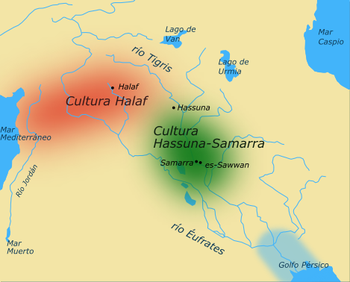
Halaf culture
Encyclopedia

Tell Halaf
Tell Halaf is an archaeological site in the Al Hasakah governorate of northeastern Syria, near the Turkish border, just opposite Ceylanpınar. It was the first find of a Neolithic culture, subsequently dubbed the Halaf culture, characterized by glazed pottery painted with geometric and animal designs...
without any strong break. The Tell Halaf site flourished from about 6100 to 5400 BCE, a period of time that is referred to as the Halaf period. The Halaf culture was succeeded in northern Mesopotamia by the Ubaid culture. The site was then abandoned for a long period.
Economy
Dryland farmingDryland farming
Dryland farming is an agricultural technique for non-irrigated cultivation of drylands.-Locations:Dryland farming is used in the Great Plains, the Palouse plateau of Eastern Washington, and other arid regions of North America, the Middle East and in other grain growing regions such as the steppes...
was practiced by the population. This type of farming was based on exploiting natural rainfall without the help of irrigation, in a similar practice to that still practiced today by the Hopi
Hopi
The Hopi are a federally recognized tribe of indigenous Native American people, who primarily live on the Hopi Reservation in northeastern Arizona. The Hopi area according to the 2000 census has a population of 6,946 people. Their Hopi language is one of the 30 of the Uto-Aztecan language...
people of Arizona
Arizona
Arizona ; is a state located in the southwestern region of the United States. It is also part of the western United States and the mountain west. The capital and largest city is Phoenix...
. Emmer wheat, two-rowed barley
Barley
Barley is a major cereal grain, a member of the grass family. It serves as a major animal fodder, as a base malt for beer and certain distilled beverages, and as a component of various health foods...
and flax
Flax
Flax is a member of the genus Linum in the family Linaceae. It is native to the region extending from the eastern Mediterranean to India and was probably first domesticated in the Fertile Crescent...
were grown. They kept cattle, sheep and goats.
Architecture
Although no Halaf settlement has been extensively excavated some buildings have been excavated: the tholoiTholos
Τholos is the name given to several Ancient Greek structures and buildings:**The Tholos at Athens was the building which housed the Prytaneion, or seat of government, in ancient Athens...
of Tell Arpachiyah
Tell Arpachiyah
Tell Arpachiyah was an Ancient Near Eastprehistoric site about 4 miles from Nineveh. The proper name of the site is Tepe Reshwa.-History:The site was occupied in the Halaf and Ubaid periods. It appears...
, circular domed structures approached through long rectangular anterooms. Only a few of these structures were ever excavated. They were constructed of mud-brick sometimes on stone foundations and may have been for ritual use (one contained a large number of female figurines). Other circular buildings were probably just houses.
Halaf pottery

Halaf pottery has been found in other parts of northern Mesopotamia, such as at Nineveh
Nineveh
Nineveh was an ancient Assyrian city on the eastern bank of the Tigris River, and capital of the Neo Assyrian Empire. Its ruins are across the river from the modern-day major city of Mosul, in the Ninawa Governorate of Iraq....
and Tepe Gawra
Tepe Gawra
Tepe Gawra is an ancient Mesopotamian settlement in northwest Iraq, near the ancient site of Nineveh, 2 miles from Khorsabad and 15 miles northeast of the modern city of Mosul. It is locatedin modern Ninawa Governorate, Iraq.-History:...
, Chagar Bazar
Chagar Bazar
Chagar Bazar is an ancient site in northern Syria, about 35 kilometers north of Al-Hasakah, occupied from the sixth to the second millennium BC. It is situated by the small river Dara, a tributary to the Khabur River. Alternative spellings are Tell Chagar Bazar, or Šagir Bazar.-History:Chagar...
and at many sites in Anatolia
Anatolia
Anatolia is a geographic and historical term denoting the westernmost protrusion of Asia, comprising the majority of the Republic of Turkey...
(Turkey
Turkey
Turkey , known officially as the Republic of Turkey , is a Eurasian country located in Western Asia and in East Thrace in Southeastern Europe...
) suggesting that it was widely used in the region. In addition, the Halaf communities made female figurines of partially baked clay and stone and stamp seal
Stamp seal
The stamp seal is a carved object, usually stone, first made in the 4th millennium BC, and probably earlier. They were used to impress their picture or inscription into soft, prepared clay....
s of stone, (see also Impression seal
Impression seal
The impression seal is a common seal that leaves an impression, typically in clay and less often in wax. In antiquity they were common, largely because they served to authenticate legal documents, such as tax receipts, contracts, wills and decrees...
). The seals are thought to mark the development of concepts of personal property, as similar seals were used for this purpose in later times. The Halaf people used tools made of stone and clay. Copper was also known, but was not used for tools.

